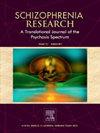精神分裂症患者跨模态联想记忆障碍的异常前额叶-海马连通性
IF 3.6
2区 医学
Q1 PSYCHIATRY
引用次数: 0
摘要
目的联想记忆(AM)损伤被认为是精神分裂症患者的核心认知功能障碍,是精神分裂症患者功能不良的标志。尽管在前额叶-海马体网络中发现了异常,但具体的区域和明确的模式仍然难以捉摸。我们采用了一种创新的AM模式来解开前额叶-海马网络的贡献。方法在本横断面研究中,招募30例精神分裂症患者和30例匹配的健康对照(hc),安排在3.0T Siemens上进行MRI检查,并完成临床评估。我们以双侧海马(Hipp)为种子进行了基于种子的功能连接(FC)分析,并在FC和AM表现之间进行了Pearson相关性分析。结果与hc相比,患者在同域和跨域条件下均表现出较差的AM功能。左侧Hipp表现出两侧内侧和眶额上回(SFG)聚集的FC减少(p-FDR <;0.001),而双侧额下回(IFG)、小脑部和三角肌(p-FDR <;与hcc相比,精神分裂症患病率为0.01)。值得注意的是,在hc组中,减少的左侧hip相关FC与跨模态AM表现呈中度正相关,而在精神分裂症组中则没有。相反,精神分裂症患者的左髋关节-双侧IFG FC值与跨模态AM能力之间存在显著正相关。结论本研究证实了AM缺陷的差异,并证实了AM与前额叶-海马网络参与的相关证据。这些发现为精神分裂症的神经病理机制提供了证据,可能指导相关的干预和治疗。本文章由计算机程序翻译,如有差异,请以英文原文为准。
Aberrant prefrontal-hippocampal connectivity of cross-modal associative memory impairment in schizophrenia
Objective
Associative memory (AM) impairment is considered as a core cognitive dysfunction and indicative of poor function in schizophrenia. Despite the robust findings of abnormalities in prefrontal-hippocampal network, yet the specific regions and definitive patterns have remained elusive. We adopted an innovative AM paradigm to disentangle the contributions of prefrontal-hippocampal network.
Methods
In this cross-sectional study, 30 schizophrenia patients and 30 matched healthy controls (HCs) were recruited, scheduled for an MRI session on a 3.0T Siemens, and completed clinical evaluations. We performed seed-based functional connectivity (FC) analyses using the bilateral hippocampus (Hipp) as seeds and conducted Pearson's correlation analyses between FC and the AM performance.
Results
Compared to HCs, patients exhibited poorer AM functions in both same- and cross-domain conditions. Left Hipp exhibited decreased FC with clusters from medial and orbital superior frontal gyrus (SFG) bilaterally (p-FDR < 0.001), while enhanced FC with clusters from bilateral inferior frontal gyrus (IFG), pars opercularis and triangularis (p-FDR < 0.01) in the schizophrenia relative to HCs. Notably, decreased left Hipp-related FC was moderately positively correlated with cross-modal AM performance in HCs but not in the schizophrenia group. Conversely, a significant positive correlation was found between left Hipp-bilateral IFG FC values and cross-modal AM capacities in schizophrenia.
Conclusions
The current study demonstrated the disparities in AM deficits and substantiate correlative evidence for prefrontal-hippocampal network involvement in AM. These findings provide evidence for neuropathological mechanisms in schizophrenia, which potentially guiding relevant interventions and treatments.
求助全文
通过发布文献求助,成功后即可免费获取论文全文。
去求助
来源期刊

Schizophrenia Research
医学-精神病学
CiteScore
7.50
自引率
8.90%
发文量
429
审稿时长
10.2 weeks
期刊介绍:
As official journal of the Schizophrenia International Research Society (SIRS) Schizophrenia Research is THE journal of choice for international researchers and clinicians to share their work with the global schizophrenia research community. More than 6000 institutes have online or print (or both) access to this journal - the largest specialist journal in the field, with the largest readership!
Schizophrenia Research''s time to first decision is as fast as 6 weeks and its publishing speed is as fast as 4 weeks until online publication (corrected proof/Article in Press) after acceptance and 14 weeks from acceptance until publication in a printed issue.
The journal publishes novel papers that really contribute to understanding the biology and treatment of schizophrenic disorders; Schizophrenia Research brings together biological, clinical and psychological research in order to stimulate the synthesis of findings from all disciplines involved in improving patient outcomes in schizophrenia.
 求助内容:
求助内容: 应助结果提醒方式:
应助结果提醒方式:


